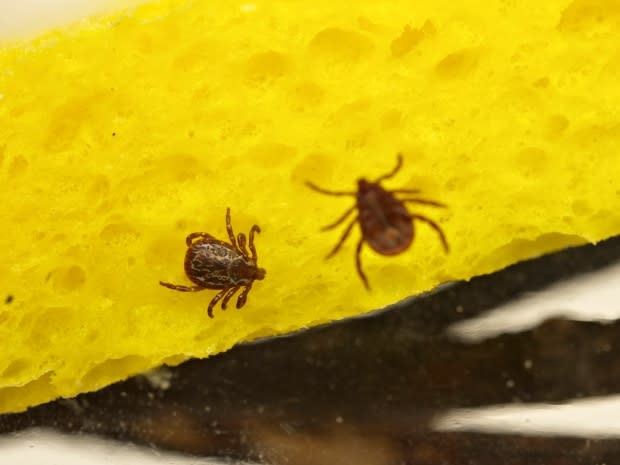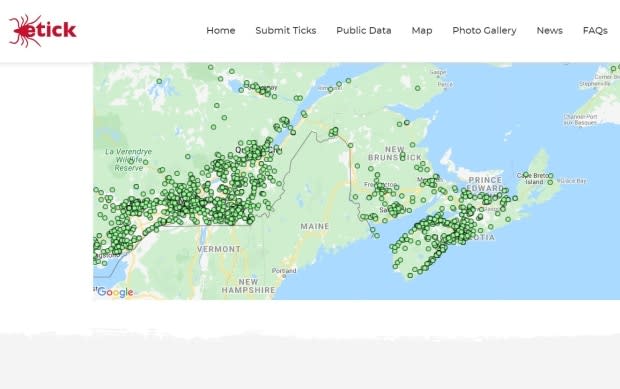New online tool helps Nova Scotians manage tick risk
Even for someone who's used to the presence of ticks, Ally Rhodes's recent experience was disconcerting.
Returning from a recent hike near South Rawdon, N.S., Rhodes started checking for the insects. She realized immediately that something was off.
"At one point my friend looked down at her shoes and she actually had between eight and 10 ticks just on her shoelace on one foot," Rhodes said "That's when we realized how bad it was."
Inspecting her dog, Rhodes found dozens more ticks — more than 40 in total. They were a mixture of dog and deer ticks.
But while the experience was unpleasant, Rhodes said she wasn't worried because she knew what to look for.
"Every tick that we found, I would look at them, and compare them, versus a lot of people don't know what they're looking at," she said. "So for people that don't know the difference, it probably would really deter them from going out anywhere."
A new citizen-science tool aims to ensure more people are equipped with that knowledge, by helping Nova Scotians identify the ticks they find — and whether those ticks pose a risk to their health.

ETick identifies ticks based on photos that users submit, as well as information they provide about where they found it.
The program was started by professor Jade Savage at Bishop's University in Quebec in 2014. It's since expanded across the country, and became available to Nova Scotians this year.
"We like to get [reports of] ticks to have an idea where people find them and also get people more aware, and talking about it," said eTick program manager Pierre Chuard, a biologist at Bishop's.
"When people know the danger, they know how to protect themselves."
Chuard said the program is founded on peer-reviewed science that established that a tick's species can be accurately identified with photos.
"That was a proof of concept, basically."
He said, according to that research, the program can accurately identify tick species about 90 per cent of the time, "but really it's higher than that, in most instances."
"So basically, it will tell you which species it is, where you can find it, what pathogen it can give, and the resources in Nova Scotia for if you need more assistance."

That assistance does not include the testing of ticks. The prevalence of certain tick-borne illnesses, namely Lyme disease, is so high in Nova Scotia, the province does not test submitted deer ticks, also known as blacklegged ticks, for Lyme.
"For public health, it does not tell them anything if it comes back positive because they already knew this part of the country had Lyme disease," said Chuard.
ETick doesn't provide testing either, but properly identifying the species can lower people's risk of Lyme by telling people whether they could have been exposed, based on the species.
The project has implications for public health and environmental research, as well.

Dave Shutler, who teaches in the biology department at Acadia University, is one of the local researchers collaborating on the project.
He said having "citizen-scientists" submit data on the ticks they're finding is a cost-effective way for governments to inform citizens about the risks.
"That's the real, I think, selling point to this project for the public, is that if if they find a tick on them, do they need to go and get penicillin right away, or can they have it identified really quickly and get told no, it's a dog tick, so you don't have to worry about Lyme disease."
This reduces the possible over-prescribing of antibiotics, Shutler said, which in turn helps tackle another public health treat: the rise of antibiotic-resistant bacteria.
From an ecological standpoint, having data gathered throughout the province, the program can provide the "big picture" when it comes through the distribution of tick species across Nova Scotia.

"If you get participation from across the province, you could have 1,000 times the amount of data that a government agency would be able to generate," Shutler said.
That data will be especially valuable as climate change alters the range of many tick species.
Chuard said research has shown definitely that ticks are receding from their southern range in the United States and moving northward.
He said data gathered from the project can help researchers monitor the distribution of existing species, and the appearance of new ones, including in remote areas, where researchers are unlikely to be monitoring for ticks.
Better data on where, and with what frequency, ticks are turning up, will help citizens and public officials understand the risks, said Chuard, adding that they don't want people to take that information as a reason to be afraid of getting outside.
"People are starting to worry a bit more, and I think that's a good thing."
"But we don't want to scare people, and actually we really promote outdoor activities, as long as you're careful."
MORE TOP STORIES

